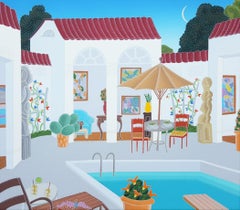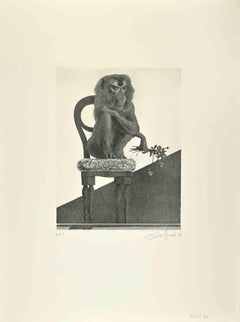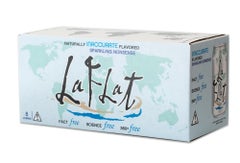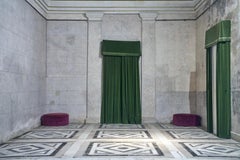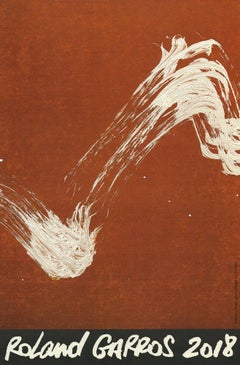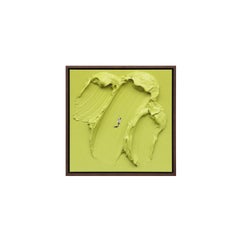Contemporary Prints and Multiples
Used to refer to a time rather than an aesthetic, Contemporary art generally describes pieces created after 1970 or being made by living artists anywhere in the world. This immediacy means it encompasses art responding to the present moment through diverse subjects, media and themes. Contemporary painting, sculpture, photography, performance, digital art, video and more frequently includes work that is attempting to reshape current ideas about what art can be, from Felix Gonzalez-Torres’s use of candy to memorialize a lover he lost to AIDS-related complications to Jenny Holzer’s ongoing “Truisms,” a Conceptual series that sees provocative messages printed on billboards, T-shirts, benches and other public places that exist outside of formal exhibitions and the conventional “white cube” of galleries.
Contemporary art has been pushing the boundaries of creative expression for years. Its disruption of the traditional concepts of art are often aiming to engage viewers in complex questions about identity, society and culture. In the latter part of the 20th century, contemporary movements included Land art, in which artists like Robert Smithson and Michael Heizer create large-scale, site-specific sculptures, installations and other works in soil and bodies of water; Sound art, with artists such as Christian Marclay and Susan Philipsz centering art on sonic experiences; and New Media art, in which mass media and digital culture inform the work of artists such as Nam June Paik and Rafaël Rozendaal.
The first decades of the 21st century have seen the growth of Contemporary African art, the revival of figurative painting, the emergence of street art and the rise of NFTs, unique digital artworks that are powered by blockchain technology.
Major Contemporary artists practicing now include Ai Weiwei, Cecily Brown, David Hockney, Yayoi Kusama, Jeff Koons, Takashi Murakami and Kara Walker.
Find a collection of Contemporary prints, photography, paintings, sculptures and other art on 1stDibs.
1980s Contemporary Prints and Multiples
Screen
1970s Contemporary Prints and Multiples
Etching
21st Century and Contemporary Contemporary Prints and Multiples
Archival Pigment, Cardboard
21st Century and Contemporary Contemporary Prints and Multiples
Archival Ink, Archival Paper, Photographic Paper, Giclée, Archival Pigment
2010s Contemporary Prints and Multiples
Offset
2010s Contemporary Prints and Multiples
Giclée
Early 2000s Contemporary Prints and Multiples
Photographic Paper, C Print, Color, Silver Gelatin
2010s Contemporary Prints and Multiples
Archival Pigment
2010s Contemporary Prints and Multiples
Giclée
1980s Contemporary Prints and Multiples
Offset
2010s Contemporary Prints and Multiples
Rag Paper, Archival Pigment
2010s Contemporary Prints and Multiples
Rag Paper, Archival Pigment
2010s Contemporary Prints and Multiples
Screen
2010s Contemporary Prints and Multiples
Giclée
21st Century and Contemporary Contemporary Prints and Multiples
Digital
2010s Contemporary Prints and Multiples
Mixed Media, Pencil, Linocut, Screen
2010s Contemporary Prints and Multiples
Canvas, Giclée
2010s Contemporary Prints and Multiples
Screen
2010s Contemporary Prints and Multiples
Paper, Monotype
21st Century and Contemporary Contemporary Prints and Multiples
Mixed Media
Early 2000s Contemporary Prints and Multiples
Offset
21st Century and Contemporary Contemporary Prints and Multiples
Offset
2010s Contemporary Prints and Multiples
Screen
1990s Contemporary Prints and Multiples
Screen
1990s Contemporary Prints and Multiples
Other Medium
2010s Contemporary Prints and Multiples
Screen
2010s Contemporary Prints and Multiples
Giclée
21st Century and Contemporary Contemporary Prints and Multiples
Screen
21st Century and Contemporary Contemporary Prints and Multiples
Inkjet
2010s Contemporary Prints and Multiples
Silver Gelatin, Color, C Print, Photographic Paper
2010s Contemporary Prints and Multiples
Archival Pigment
2010s Contemporary Prints and Multiples
Screen
2010s Contemporary Prints and Multiples
Archival Pigment
21st Century and Contemporary Contemporary Prints and Multiples
Archival Ink, Archival Paper, Photographic Paper, Giclée, Archival Pigment
1970s Contemporary Prints and Multiples
Screen
2010s Contemporary Prints and Multiples
Screen
Early 2000s Contemporary Prints and Multiples
Offset
2010s Contemporary Prints and Multiples
Archival Ink, Color
2010s Contemporary Prints and Multiples
Archival Pigment
21st Century and Contemporary Contemporary Prints and Multiples
Archival Ink, Archival Paper, Photographic Paper, Giclée, Archival Pigment
Early 2000s Contemporary Prints and Multiples
Screen
2010s Contemporary Prints and Multiples
Encaustic, Archival Paper, Monotype
2010s Contemporary Prints and Multiples
Giclée
2010s Contemporary Prints and Multiples
Giclée
1990s Contemporary Prints and Multiples
Other Medium
1980s Contemporary Prints and Multiples
Screen
21st Century and Contemporary Contemporary Prints and Multiples
Archival Paper, Photographic Paper, Giclée, Archival Pigment
1990s Contemporary Prints and Multiples
Offset
20th Century Contemporary Prints and Multiples
Offset
21st Century and Contemporary Contemporary Prints and Multiples
Archival Pigment
2010s Contemporary Prints and Multiples
Photographic Paper, C Print, Color, Silver Gelatin
Early 2000s Contemporary Prints and Multiples
Offset
1980s Contemporary Prints and Multiples
Etching
Early 2000s Contemporary Prints and Multiples
Screen
2010s Contemporary Prints and Multiples
Ceramic
2010s Contemporary Prints and Multiples
Giclée
2010s Contemporary Prints and Multiples
Paper, Archival Paper, Rag Paper, Monotype, Photogram
2010s Contemporary Prints and Multiples
Giclée
Late 20th Century Contemporary Prints and Multiples
Lithograph
2010s Contemporary Prints and Multiples
Paper
